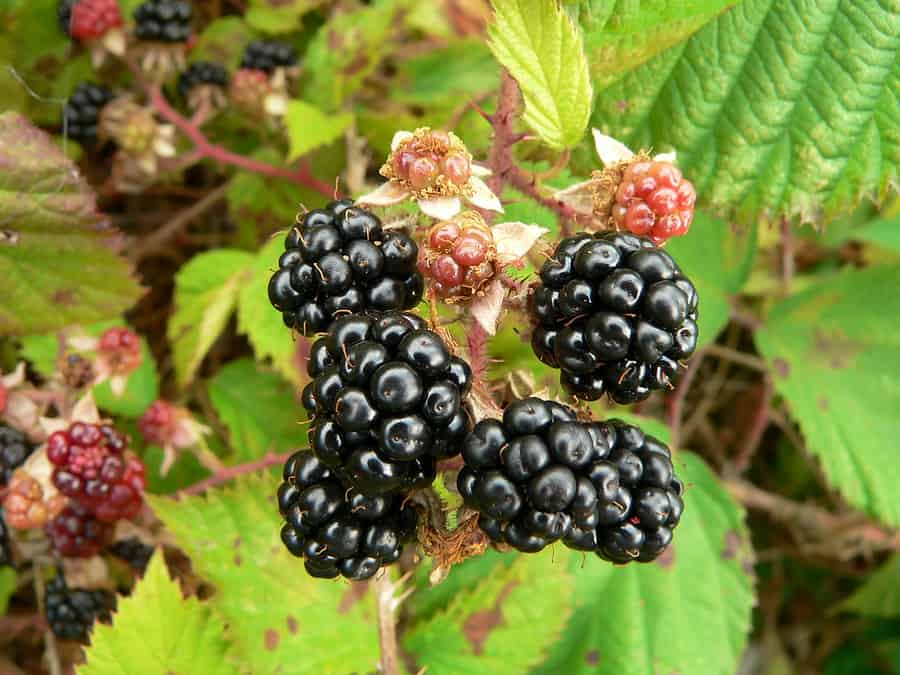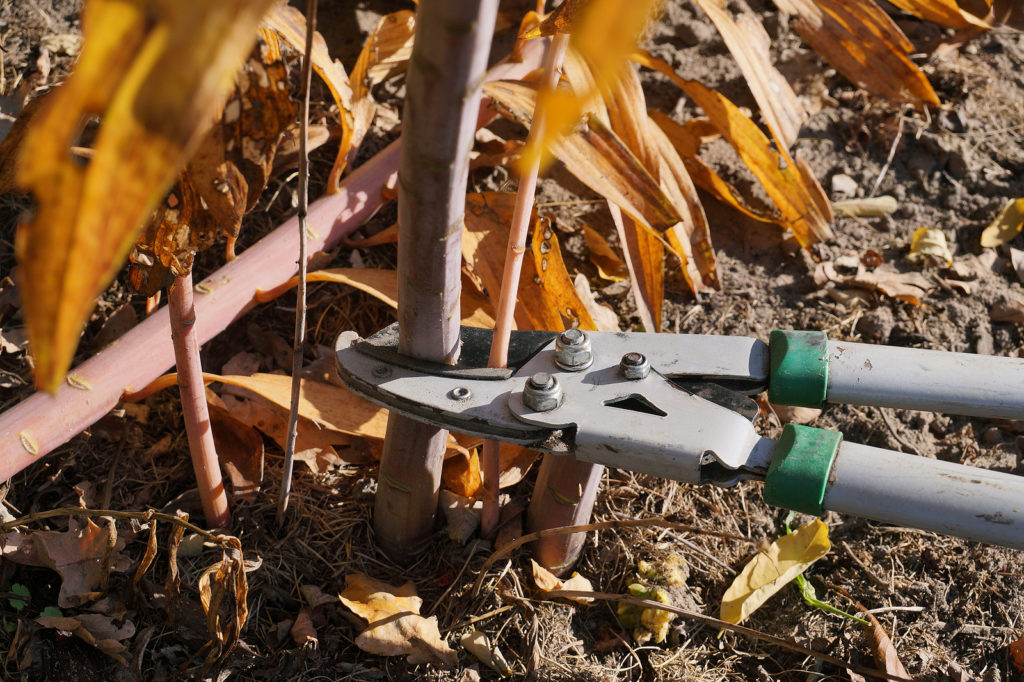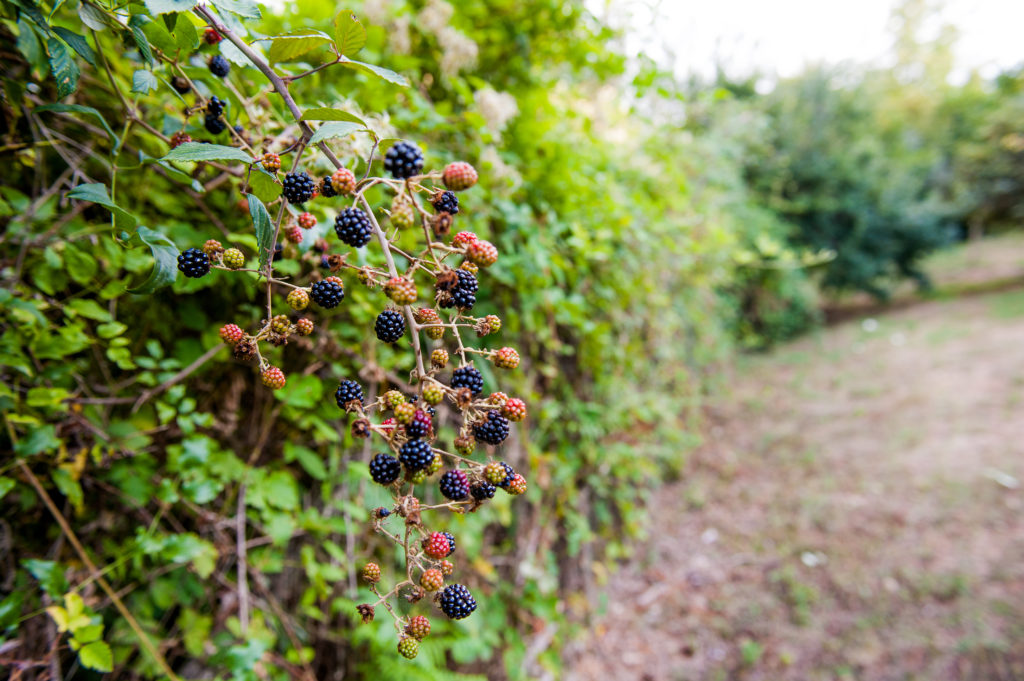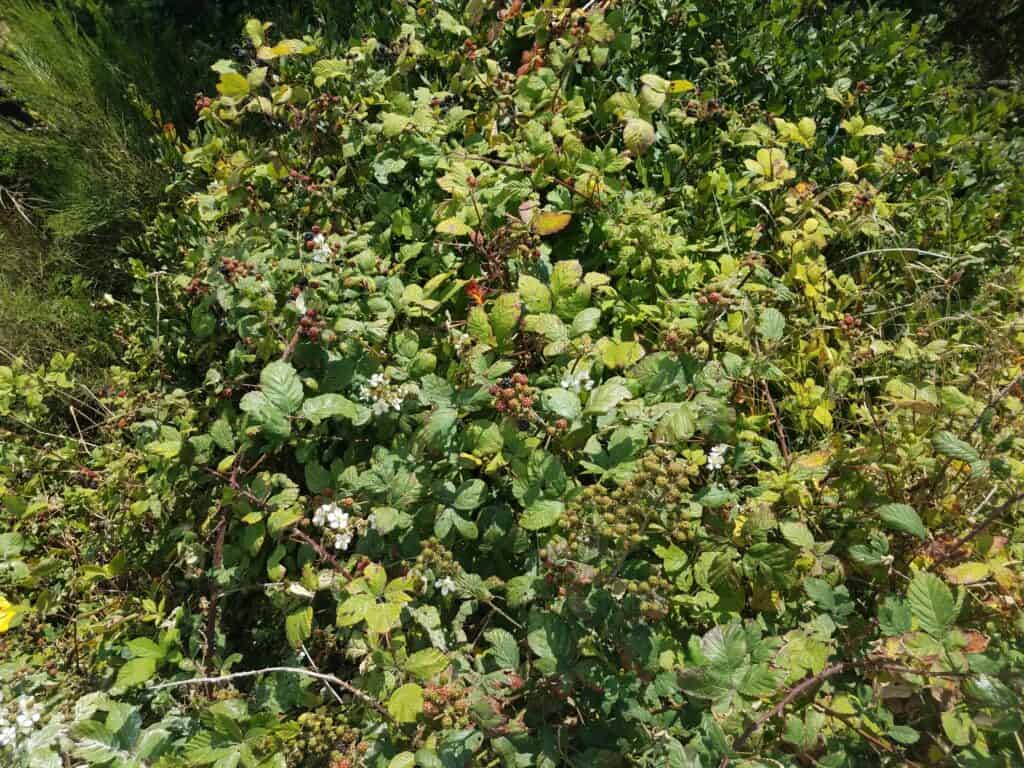Blackberry plants are easy to plant and grow. The blackberry is a vigorous grower. Modern blackberry varieties and cultivars are derived from native species which are still found growing wild along roadsides.
Blackberry plants vary from trailing to erect to bushy and from thorny to thornless. Some varieties and cultivars are suited for chilly northern regions, others are good growers in warm, southern regions. It is important to pick the blackberry plants suited for your region and garden.
Blackberries are sometimes called dewberries. Blackberry varieties include ‘Boysen’—often called boysenberries, and ‘Logan’ often called loganberries. Other blackberry varieties include ‘Marion’, called marionberries, and ‘Olallie’ called olallieberries. These widely adapted cultivars are blackberries.
Related article:
Here is your complete guide to growing the blackberry plant.
Best climate and site for growing blackberries
- Blackberries grow best in USDA Zones 5 to 9; check at a nearby garden center or the cooperative extension for varieties recommended for your region.
- Plant blackberries in full sun. Fruit yield will be reduced if blackberries are planted in shade.
- Chose a location where there is plenty of air circulation but away from a constant breeze or wind.
- Plant cultivated blackberries at least 1,000 feet away from wild blackberries to prevent disease infection.
- Avoid planting blackberries in a windy location; wind can damage the canes.
- Do not plant blackberries where other brambles, tomatoes, or roses have grown in the past few years; soilborne diseases such as Verticillium wilt or crown gall can remain in the soil where brambles have grown recently. Plant away from wild blackberries.
- Plant in a well-drained, loamy soil. Add aged compost or commercial organic planting mix to the soil and turn it under to 12 inches before planting.
- Blackberries prefer a soil pH of 5.5 to 6.5.

Choosing the right blackberry plant
- There are three types of blackberry plants: (1) standard upright, thorny stemmed plants; (2) floppy, thornless plants that require a trellis or other support; (3) upright, thornless cultivars.
- Plants are available in containers and bare roots. Plant bare roots in spring; container-grown plants can be planted in spring or fall, but not during hot, dry weather.
- Choose one-year-old dormant plants with lots of roots.
- Be sure to select certified virus-free plants; virus infection is the most common blackberry disease.
- Blackberries are self-fertile, so you can plant just one cultivar.
Yield and how much to plant
- Yield depends on the size and vigor of the plant. Most plants will produce 10 to 30 pounds of berries each year.
Blackberry pollination
- Most blackberries are self-fertile, but a few require cross-pollination. Check to see what varieties or cultivars you are growing and if they require a pollinator.
- Grow cultivars that flower early, midseason, and late; these will ripen at different times and extend the harvest.
Spacing blackberries
- Space thorny blackberries 3 to 4 feet apart.
- Plant thornless blackberries 4 to 6 feet apart.
- Space blackberry rows 8 to 10 feet apart; this will ensure good sun exposure and air circulation.
Planting blackberries
- Plant blackberries in spring or fall.
- Soak bare-root plants in compost tea for 20 minutes before planting.
- Prepare a planting hole half again as deep as the root ball and twice as wide.
- Add a mixture of 2 cups of kelp and 1 cup of bone meal to the hole prior to planting.
- Set the plant in the hole and refill the hole around the root ball with a combination of native soil and aged compost or commercial organic planting mix. Firm in the soil so that no air pockets remain near the roots.
- Mulch blackberries planted in the fall to prevent frost from heaving plants out of the soil.
Container growing blackberries
- Blackberries can be grown in containers; however, their spreading habit and thorns can be problematic in confined areas.
- Choose a large container with good drainage. Use an organic potting mixture.
- Repot blackberries every year when the plants are dormant.

Blackberry care, nutrients, and water
- Keep the soil evenly moist throughout the growing season; avoid wetting the foliage.
- Water at least once a week when berries are turning from red to black.
- Topdress the soil around blackberries with an all-purpose organic fertilizer in early spring.
- Blackberries have shallow roots; protect shallow roots with a thick mulch of aged compost.
- Mulch over the roots of plants with a 2 to 3-inch layer of aged compost or chopped leaves at least twice a year. Mulch in spring after feeding the plants.
- Mowed between rows; this will keep blackberries from spreading and keep down weeds that can harbor pests and diseases.
- Keep birds away from ripening berries by covering plants with netting.
Training blackberries
- Give blackberries support. Trellis blackberries so they are easy to harvest, and canes and berries are exposed to air and sunlight; this will also decrease disease.
- A trellis of wires stretched between posts will be enough to keep canes off the ground. Stretch wires at 12 to 18-inch intervals between posts set firmly in the ground. Use sturdy 7-foot posts set 2½ deep in the ground. Train canes up the wires. The top wire should not be more than 5 feet above the ground; this will put berries within easy reach for harvesting.
- Tie new canes away from canes that will fruit this season. New canes will fruit next season.

Pruning blackberries
- Blackberry roots are perennial but the canes are biennial; they live for two growing seasons. An individual cane will die after bearing its summer crop of berries in the second year.
- A blackberry plant will have a combination of young canes and fruiting canes (that is first-year canes and two-year-old canes).
- Prune to selectively remove canes that have borne fruit and will soon die. This will allow the first-year canes to grow to replace the old canes. The first-year canes will bear fruit next summer.
- Prune canes down to ground level after they have borne fruit—usually late summer shortly after the berries have been picked. (If you wait until winter to prune, you may not be able to distinguish between young canes and old canes.)
- In winter prune away thin canes and bent canes; leave two to four sturdy canes for each foot of row or six to seven canes per plant. Winter pruning is often referred to as thinning.
- Blackberry canes fruit only once. The object of pruning is to remove fruited canes and select strong canes for fruiting the following year.
- Do not prune cane tips; blackberries fruit at the end of canes.
Propagating blackberries
- Blackberries are easily propagated by tip layering in late summer. Bend a branch tip to the ground, cover it with soil, and hold it down with a garden staple or rock. Roots will form along the buried stem. The following spring cut the rooted tip away from the mother plant and transplant it.
- Blackberries can also be propagated by the division of clumps or by digging up suckers that appear near the mother plant. Remove and transplant suckers that appear outside the row.

Harvesting and storing blackberries
- Pick blackberries when the fruits are ripe; ripe berries will turn from bright red to blackish red and from shiny to dull. Ripe fruit will be soft and come away from the plant with little effort. The plug or core will come away from the plant with the berry (unlike raspberries).
- Unripe blackberries will not pull away from the plant easily; they will resist harvest. Unripe berries will not ripen off the plant.
- Let berries remain on the plant as long as possible to develop maximum flavor and sweetness.
- For the best flavor, harvest in the morning after the dew has dried but before it gets too hot.
- Place harvested fruit in a shallow container—about three or four berries deep—to avoid crushing the fruit.
- Blackberries will keep two or three days in the refrigerator, not longer. Freeze berries you cannot use right away.
- Harvest from an individual plant will usually last about two weeks.
- Early varieties will come to harvest in late spring or early summer; late varieties will come to harvest in late summer and fall. Varieties grown in warm climates will come to harvest before the same variety grown in a cooler climate.
- Blackberry canes fruit only once; fruited canes should be pruned away to make room for the next fruiting canes.
Also of interest–see these posts:
How to Make Blackberry Ice Cream
Blackberry problems and control
- Spray plants with compost tea when fruits form to help prevent gray mold. Spray early in the day to allow plants to dry before sunset.
- If powdery mildew (powdery coating on leaves) or cane disease was a problem last year, spray plants with lime sulfur in spring when buds begin to form.
- Orange pustules on leaves are a sign of rust disease; spray plants with compost tea or a fungicide.
- If fruitworms were a problem last year, spray plans with rotenone or pyrethrins in spring when buds appear.
- Yellow mosaic patterns on leaves or crumbly berries can be a sign of viral disease. Remove infected plants from the garden. Viral diseases cannot be cured.
- Small holes eaten in leaves can be a sign of tarnished plant bug or lygus bug damage; spray plants with insecticidal soap or Spinosad spray.
- Cane dieback can be a sign of Verticillium wilt or crown borer damage; prune away damaged stems immediately; if wilt continues remove the plant from the garden.

Fall and winter blackberry care
- Remove spent canes in late summer or fall after harvest is done.
- Tie in new canes to the trellis; new canes will fruit next summer.
- Keep blackberry rows and the garden free of dropped leaves and fruit; these can harbor disease over the winter.
- Rake mulch away from plants in autumn; this will prevent mice from nesting under the mulch. After the first freeze rake the mulch back over plant roots.
- Control the width of blackberry rows in winter.
- Prune canes in winter if they were not pruned right after harvest.
Blackberry varieties to grow
- Thornless cultivars include: ‘Navaho Erect’, ‘Arapaho’, ‘Loch Ness’, ‘Oregon Thornless’, ‘Waldo’, ‘Helen’, ‘Thornfree’, ‘Thornless Evergreen’.
- Hardy cultivars for northern regions include: ‘Illini Hardy’ and ‘Darrow’.
- Southern region’s cultivars include: ‘Rosborough’, ‘Dirksen’, and ‘Black Satin’.
- Orange rust-resistant cultivars include: ‘Arapaho’, ‘Chester’,‘Shawnee’, ‘Silvan’, ‘Helen’.
Five famous blackberry hybrids
- Logan’, known as loganberry (created in 1881) tasty flavor more acidic than ‘Boysen’; excellent for canning and pies; dusty maroon to reddish fruit to 1¼ long; covered with fine hairs that dull the color; trailing plant. The loganberry is a hybrid of blackberry and raspberry.
- ‘Youngberry’ (released in 1926): a sweet, juicy red berry that looks like a raspberry; it is a complex hybrid between three different species from the genus Rubus, the raspberries, blackberries, and dewberries; used to make pies, jams, and juice.
- ‘Boysen’, known as boysenberry (developed in the late 1920s): fine flavor reminiscent of raspberries and a distinct aroma; black, large berries to 1¼ inch long; reddish-black at maturity; trailing with small thorns; thornless strains are less productive. The boysenberry is a cross of the European raspberry, European blackberry, American dewberry, and loganberry.
- ‘Olallie’, known as olallieberry (released in 1950): excellent for pies and jams; large, glossy black fruit with firm flesh; lower chilling requirements than ‘Boysen’; thorny, trailing plant. The olallieberry is a cross between the ‘Black Logan’ (syn. ‘Mammoth’) blackberry and the youngberry.
- ‘Marion’, known as marionberry (released in 1956): excellent flavor for canning, freezing, pies, and jam; black, medium to large fruit with medium-firm flesh; trailing plant; longer harvest than ‘Boysen’. Marionberry is a cross between the ‘Chehalem’ and ‘Olallie’ blackberries.
Related articles:
How to Plant and Grow Raspberries
How to Plant and Grow Blueberries
Garden Planning Books at Amazon:
- Vegetable Garden Almanac & Planner
- Kitchen Garden Grower’s Guide Vegetable Encyclopedia
- Vegetable Garden Grower’s Guide
- Tomato Grower’s Answer Book
More fruit-growing tips:
Learn how to plant, grow, prune, and harvest your favorite fruits. Click below for all you need to know.
- Apple
- Apricot
- Avocado
- Banana
- Blackberry
- Blueberry
- Cantaloupe
- Chayote
- Cherimoya
- Cherry
- Citrus
- Clementine
- Cranberry
- Currants
- Elderberry
- Feijoa
- Fig
- Gooseberry
- Grape
- Grapefruit
- Guava
- Kiwifruit
- Kumquat
- Lemon
- Lime
- Loquat
- Mandarin
- Mango
- Melon
- Mulberry
- Muskmelon
- Nectarine
- Olive
- Orange
- Papaya
- Passion Fruit
- Peach
- Pear
- Persimmon
- Pineapple
- Pineapple Guava
- Plantain
- Plum
- Pomegranate
- Pumpkin
- Quince
- Raspberry
- Strawberry
- Tangelo
- Tangerine
- Tangor
- Watermelon















